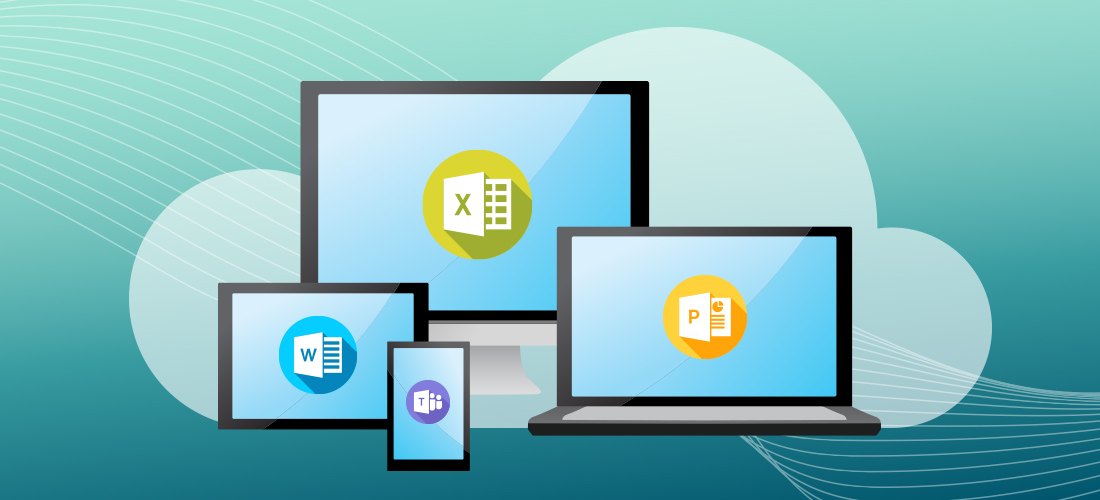Microsoft 365 vs. Office 365
Microsoft 365 vs. Office 365
What is Office 365?
Microsoft launched Office 365 in 2011. It has its roots in two separate earlier products.
The first one might be obvious: Microsoft Office. Introduced in 1988, Office bundled together three core productivity applications: Word, Excel and PowerPoint. Later editions expanded this list to include tools like OneNote, Outlook, Publisher and Access.
Despite its name, however, Office 365 is not simply the Office productivity applications moved to the cloud. Office 365 does offer the Microsoft Office applications using a subscription model, constantly providing users with fixes, updates and new features, including functionality not included in the traditional desktop Office suites. But Office 365 is actually more the successor of Microsoft’s Business Productivity Online Suite (BPOS) — a set of enterprise products delivered as a subscription service hosted by Microsoft as part of its Online Services. Chief among those products were the 2007 versions of Exchange, SharePoint and Lync (which later became Skype for Business). Launched in 2008, BPOS was primarily served smaller businesses.
With Office 365, Microsoft leapt into the software-as-a-service (SaaS) world with a solution built for organizations of all sizes. Indeed, the first release of Office 365 was based on the cloud-centric 2010 versions of the enterprise products in BPOS. For example, in BPOS, SharePoint was little more than a repository for document sharing, while in Office 365, it became a true collaboration tool.
What is Microsoft 365?
Microsoft updated and enhanced its Office 365 platform dramatically over the years. For example, it ventured into social networking with Yammer; into business intelligence and data mining with Power BI; and into teamwork organization with Planner. In 2017, it launched Microsoft Teams, which has quickly become the collaboration platform of choice for organizations around the globe. It’s really no surprise that by 2017, revenue from Office 365 was exceeding conventional license sales.
It’s also no surprise that the moniker “Office 365” now seemed inadequate for the vastly expanded platform. In July 2017, Microsoft launched the brand Microsoft 365. Initially, it was little more than a marketing or licensing exercise, establishing a bundle that allowed enterprise customers to buy Office 365 Enterprise (E3 and E5); Enterprise Mobility and Security; and Windows 10 Enterprise. As that bundle gained popularity, Microsoft began applying the new brand more liberally. In particular, in 2020, Office 365 plans designed for consumer and small business use were rebranded as Microsoft 365: Office 365 Personal became Microsoft 365 Personal, Office 365 Home became Microsoft 365 Family, and so on.
Moreover, since the launch of the brand, Microsoft has transformed Microsoft 365 from a simple bundle of products into a coherent and comprehensive cloud productivity platform with not just discrete products but broader functionality like information governance, information protection and compliance. (Certain features require more expensive licensing plans.)
Office 365 vs Microsoft 365
So, why is “Office 365” still around? Mainly because changing large, multi-year plans is difficult, time-consuming and confusing. As a result, there are still enterprise customers with Office 365 E1, E3 and E5 plans, and probably customers with that still have Office 365 G (government), F (front-line) or A (education) plans.
Moving everybody to Microsoft 365 licenses will take time. Updating all the Microsoft documentation will take even longer, and third-party publications might never be revised. As a result, you will still encounter plenty of references to “Office 365” enterprise services — especially Exchange Online, SharePoint Online and OneDrive for Business. More recent platform components and broader functionality, such as Microsoft Teams and Microsoft Information Governance (MIG), are more properly considered part of “Microsoft 365.”
What is Azure Active Directory (AD) and where does it fit in?
Azure Active Directory (Azure AD) is Microsoft’s cloud-based identity-as-a-service (IDaaS) solution. It provides authentication, credential management, application management, device management, information security and more, and includes features like single sign-on and multifactor authentication (MFA). It can be synced with your on-premises Active Directory. Your Azure AD tenant is a specific instance of Azure AD that contains your organization’s accounts and groups.
Microsoft 365 uses Azure AD to manage user identities behind the scenes, including helping users to sign in and access resources. For example, when someone creates a team in Microsoft Teams, the application automatically creates a Microsoft 365 group, which will contain all the Azure AD users who are members of the team, in order to control access to the team’s resources. Each Microsoft 365 subscription includes a free Azure AD subscription, and you can upgrade to a paid subscription if you want more advanced Azure AD features.
Your Microsoft 365 tenant is the set of services assigned to your organization. Many organizations have multiple Microsoft 365 tenants, due to mergers and acquisitions, the need for administrative isolation, or decentralized IT teams.
Keep in mind that while Azure AD is vital to Microsoft 365, it is by no means limited to Microsoft 365. In particular, Azure AD can provide single sign-on for thousands of other SaaS applications.
Blogs

9 ways to speed up your Microsoft 365 migration

Email archive migrations: Why fold them into a Microsoft 365 migration strategy

Understanding the cyber kill chain and how it impacts Microsoft 365

